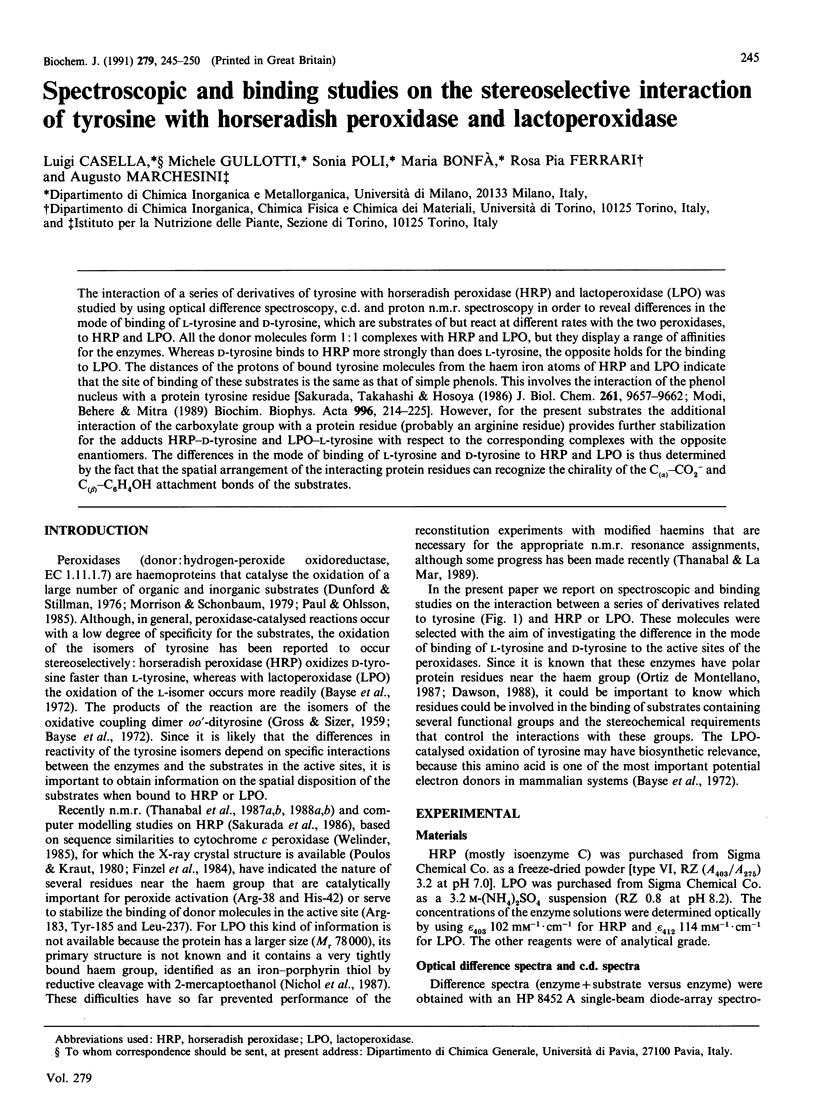Abstract
The interaction of a series of derivatives of tyrosine with horseradish peroxidase (HRP) and lactoperoxidase (LPO) was studied by using optical difference spectroscopy, c.d. and proton n.m.r. spectroscopy in order to reveal differences in the mode of binding of L-tyrosine and D-tyrosine, which are substrates of but react at different rates with the two peroxidases, to HRP and LPO. All the donor molecules form 1:1 complexes with HRP and LPO, but they display a range of affinities for the enzymes. Whereas D-tyrosine binds to HRP more strongly than does L-tyrosine, the opposite holds for the binding to LPO. The distances of the protons of bound tyrosine molecules from the haem iron atoms of HRP and LPO indicate that the site of binding of these substrates is the same as that of simple phenols. This involves the interaction of the phenol nucleus with a protein tyrosine residue [Sakurada, Takahashi & Hosoya (1986) J. Biol. Chem. 261, 9657-9662; Modi, Behere & Mitra (1989) Biochim. Biophys. Acta 996, 214-225]. However, for the present substrates the additional interaction of the carboxylate group with a protein residue (probably an arginine residue) provides further stabilization for the adducts HRP-D-tyrosine and LPO-L-tyrosine with respect to the corresponding complexes with the opposite enantiomers. The differences in the mode of binding of L-tyrosine and D-tyrosine to HRP and LPO is thus determined by the fact that the spatial arrangement of the interacting protein residues can recognize the chirality of the C(alpha)-CO2- and C(beta)-C6H4OH attachment bonds of the substrates.
Full text
PDF





Selected References
These references are in PubMed. This may not be the complete list of references from this article.
- Araiso T., Dunford H. B. Horseradish peroxidase. Complex formation with anions and hydrocyanic acid. J Biol Chem. 1981 Oct 10;256(19):10099–10104. [PubMed] [Google Scholar]
- Bayse G. S., Michaels A. W., Morrison M. The peroxidase-catalyzed oxidation of tyrosine. Biochim Biophys Acta. 1972 Sep 19;284(1):34–42. doi: 10.1016/0005-2744(72)90043-5. [DOI] [PubMed] [Google Scholar]
- Dawson J. H. Probing structure-function relations in heme-containing oxygenases and peroxidases. Science. 1988 Apr 22;240(4851):433–439. doi: 10.1126/science.3358128. [DOI] [PubMed] [Google Scholar]
- Dolman D., Dunford H. B., Chowdhury D. M., Morrison M. The kinetics of cyanide binding by lactoperoxidase. Biochemistry. 1968 Nov;7(11):3991–3996. doi: 10.1021/bi00851a028. [DOI] [PubMed] [Google Scholar]
- Finzel B. C., Poulos T. L., Kraut J. Crystal structure of yeast cytochrome c peroxidase refined at 1.7-A resolution. J Biol Chem. 1984 Nov 10;259(21):13027–13036. [PubMed] [Google Scholar]
- GROSS A. J., SIZER I. W. The oxidation of tyramine, tyrosine, and related compounds by peroxidase. J Biol Chem. 1959 Jun;234(6):1611–1614. [PubMed] [Google Scholar]
- Hosoya T., Sakurada J., Kurokawa C., Toyoda R., Nakamura S. Interaction of aromatic donor molecules with lactoperoxidase probed by optical difference spectra. Biochemistry. 1989 Mar 21;28(6):2639–2644. doi: 10.1021/bi00432a042. [DOI] [PubMed] [Google Scholar]
- Hsu M. C., Woody R. W. The origin of the heme Cotton effects in myoglobin and hemoglobin. J Am Chem Soc. 1971 Jul 14;93(14):3515–3525. doi: 10.1021/ja00743a036. [DOI] [PubMed] [Google Scholar]
- Kainosho M., Ajisaka K. Letter: Conformational analysis of amino acids and peptides using specific isotope substitution. II. Conformation of serine, tyrosine, phenylalanine, aspartic acid, asparagine, and aspartic acid beta-methyl ester in various ionization states. J Am Chem Soc. 1975 Sep 17;97(19):5630–5631. doi: 10.1021/ja00852a077. [DOI] [PubMed] [Google Scholar]
- La Mar G. N., de Ropp J. S., Smith K. M., Langry K. C. Proton nuclear magnetic resonance study of the electronic and molecular structure of the heme crevice in horseradish peroxidase. J Biol Chem. 1980 Jul 25;255(14):6646–6652. [PubMed] [Google Scholar]
- Modi S., Behere D. V., Mitra S. Binding of aromatic donor molecules to lactoperoxidase: proton NMR and optical difference spectroscopic studies. Biochim Biophys Acta. 1989 Jul 6;996(3):214–225. doi: 10.1016/0167-4838(89)90250-1. [DOI] [PubMed] [Google Scholar]
- Morishima I., Ogawa S. Nuclear magnetic resonance studies of hemoproteins. Binding of aromatic donor molecules to horseradish peroxidase. J Biol Chem. 1979 Apr 25;254(8):2814–2820. [PubMed] [Google Scholar]
- Morrison M., Schonbaum G. R. Peroxidase-catalyzed halogenation. Annu Rev Biochem. 1976;45:861–888. doi: 10.1146/annurev.bi.45.070176.004241. [DOI] [PubMed] [Google Scholar]
- Nichol A. W., Angel L. A., Moon T., Clezy P. S. Lactoperoxidase haem, an iron-porphyrin thiol. Biochem J. 1987 Oct 1;247(1):147–150. doi: 10.1042/bj2470147. [DOI] [PMC free article] [PubMed] [Google Scholar]
- Paul K. G., Ohlsson P. I. Equilibria between horseradish peroxidase and aromatic donors. Acta Chem Scand B. 1978;32(6):395–404. doi: 10.3891/acta.chem.scand.32b-0395. [DOI] [PubMed] [Google Scholar]
- Poulos T. L., Kraut J. The stereochemistry of peroxidase catalysis. J Biol Chem. 1980 Sep 10;255(17):8199–8205. [PubMed] [Google Scholar]
- Sakurada J., Takahashi S., Hosoya T. Nuclear magnetic resonance studies on the spatial relationship of aromatic donor molecules to the heme iron of horseradish peroxidase. J Biol Chem. 1986 Jul 25;261(21):9657–9662. [PubMed] [Google Scholar]
- Sakurada J., Takahashi S., Shimizu T., Hatano M., Nakamura S., Hosoya T. Proton and iodine-127 nuclear magnetic resonance studies on the binding of iodide by lactoperoxidase. Biochemistry. 1987 Oct 6;26(20):6478–6483. doi: 10.1021/bi00394a028. [DOI] [PubMed] [Google Scholar]
- Schejter A., Lanir A., Epstein N. Binding of hydrogen donors to horseradish peroxidase: a spectroscopic study. Arch Biochem Biophys. 1976 May;174(1):36–44. doi: 10.1016/0003-9861(76)90321-0. [DOI] [PubMed] [Google Scholar]
- Shiro Y., Morishima I. Structural characterization of lactoperoxidase in the heme environment by proton NMR spectroscopy. Biochemistry. 1986 Oct 7;25(20):5844–5849. doi: 10.1021/bi00368a002. [DOI] [PubMed] [Google Scholar]
- Thanabal V., La Mar G. N. A nuclear Overhauser effect investigation of the molecular and electronic structure of the heme crevice in lactoperoxidase. Biochemistry. 1989 Aug 22;28(17):7038–7044. doi: 10.1021/bi00443a039. [DOI] [PubMed] [Google Scholar]
- Thanabal V., La Mar G. N., de Ropp J. S. A nuclear Overhauser effect study of the heme crevice in the resting state and compound I of horseradish peroxidase: evidence for cation radical delocalization to the proximal histidine. Biochemistry. 1988 Jul 26;27(15):5400–5407. doi: 10.1021/bi00415a003. [DOI] [PubMed] [Google Scholar]
- Welinder K. G. Plant peroxidases. Their primary, secondary and tertiary structures, and relation to cytochrome c peroxidase. Eur J Biochem. 1985 Sep 16;151(3):497–504. doi: 10.1111/j.1432-1033.1985.tb09129.x. [DOI] [PubMed] [Google Scholar]


